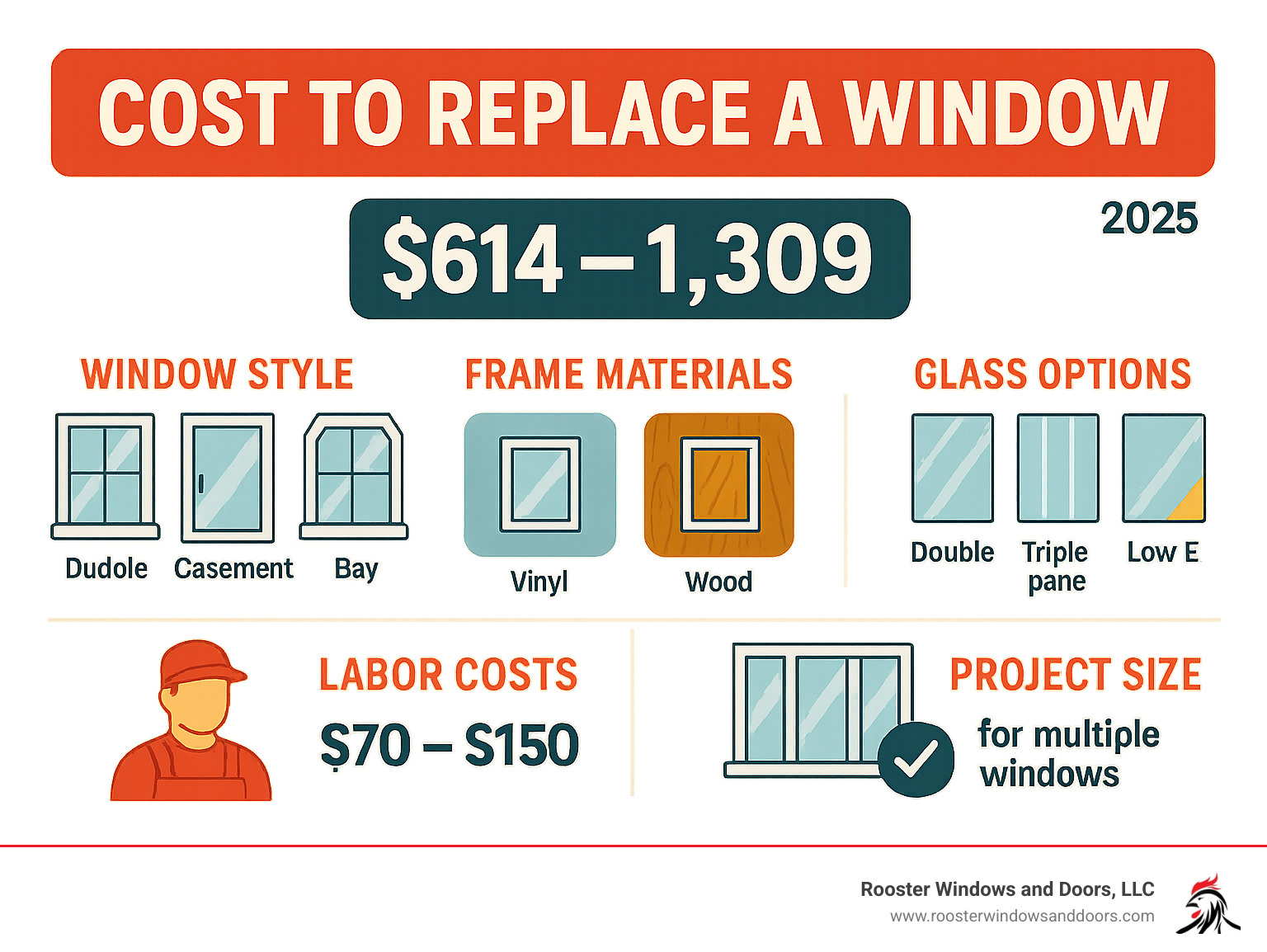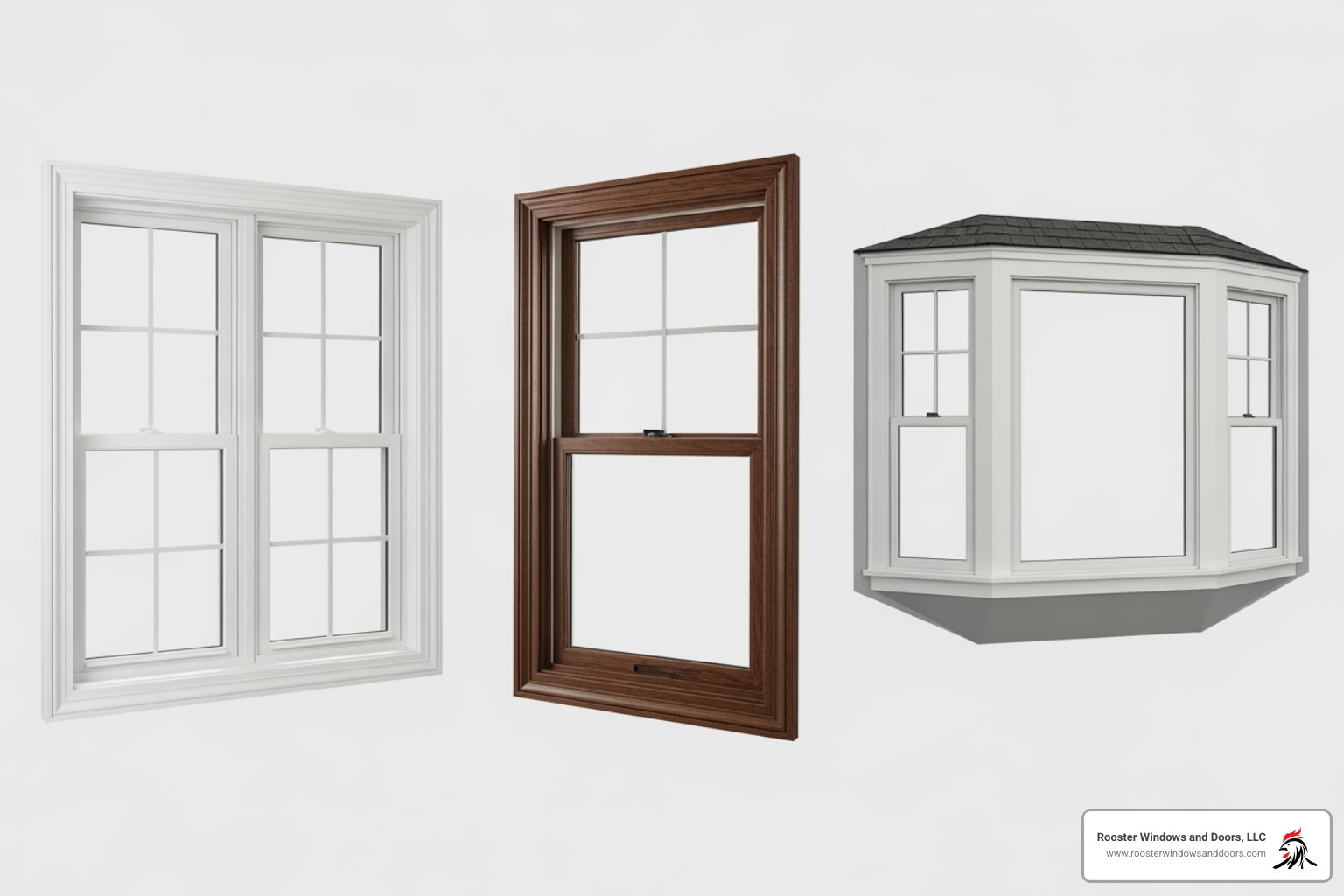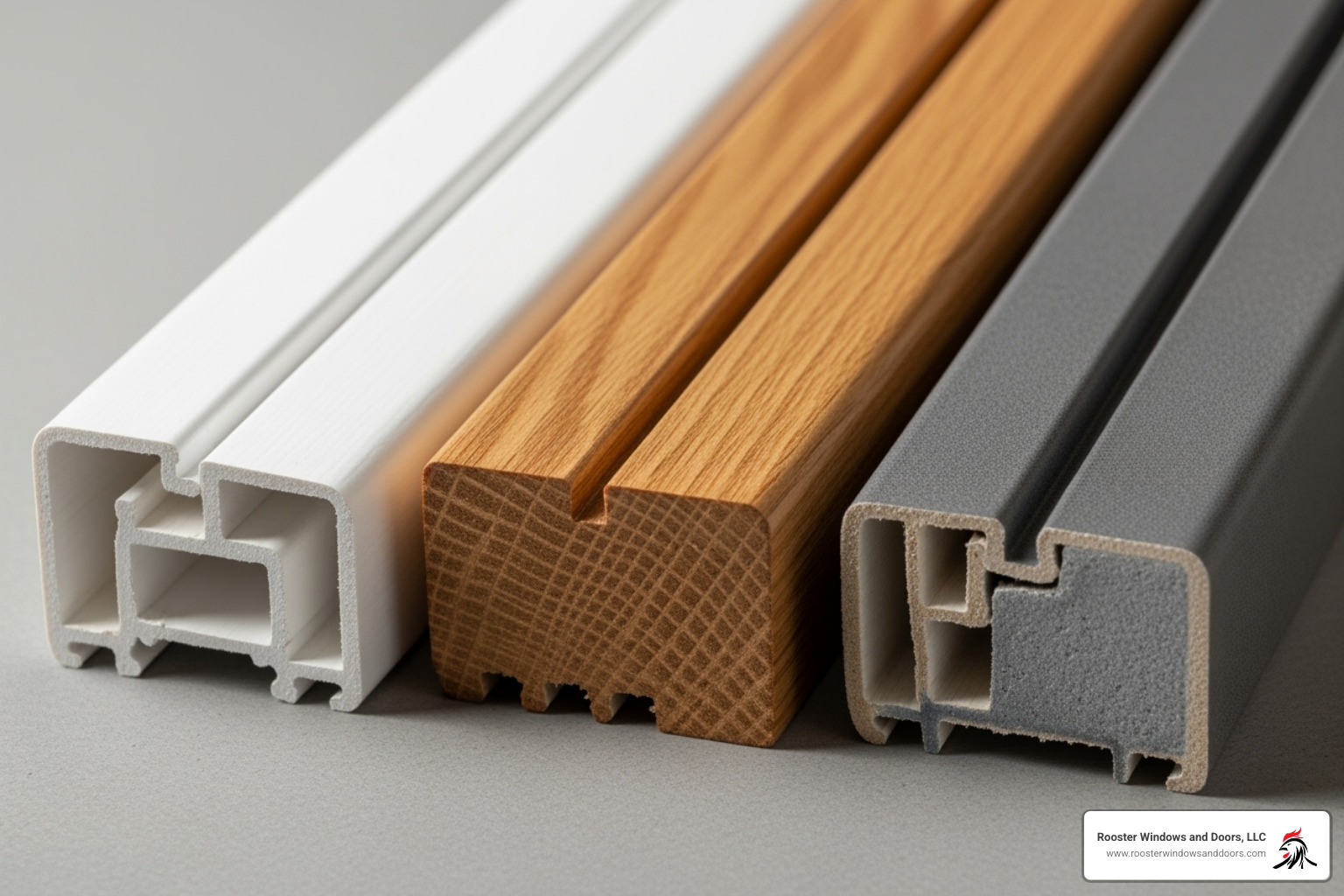Understanding the True Cost to Replace a Window
The cost to replace a window typically ranges from $614 to $1,309 per window, including installation. Here’s what affects your final price:
- Window style: Double-hung ($429-$915), casement ($597-$1,273), bay windows ($1,732-$3,690)
- Frame material: Vinyl ($391-$834), wood ($875-$1,865), fiberglass ($320-$683)
- Glass type: Double-pane ($613-$1,307), triple-pane ($400-$1,000), Low-E coating adds $35-$40
- Labor costs: $70-$150 per window for professional installation
- Project size: Replacing 10 windows averages $4,500-$15,000
Whether you’re dealing with drafty windows that won’t open properly or planning a full home upgrade, understanding these costs helps you budget effectively. The investment pays off through improved energy efficiency, improved curb appeal, and increased home value.
Most homeowners find that replacing multiple windows at once saves money through bulk discounts and reduced labor costs. Energy-efficient windows can cut your utility bills by up to 13% annually, making quality replacements a smart long-term investment.
I’m Piotr Wilk, and for over two decades, I’ve helped Chicagoland homeowners steer the cost to replace a window through quality installations across Lake, Cook, and McHenry Counties. My experience with both single-window projects and full-house replacements gives me insight into what truly drives pricing and value in window replacement projects.

Breaking Down the Average Cost to Replace a Window
When planning your window replacement project, understanding the numbers helps you budget with confidence. The cost to replace a window nationally ranges from $614 to $1,309 per window, including both materials and professional installation. This is a broad average, and your specific project in the Chicagoland area could fall inside or outside this range depending on your choices.
Think of this price like a recipe—each ingredient contributes to the final result. The window unit itself makes up the largest portion, typically around $383 to $815 per unit. This covers everything from the frame and glass package to the high-quality hardware that ensures your window functions smoothly for years to come.
Labor costs add another $70 to $150 per window to your total investment, but this is where quality truly shines. This isn’t just about popping in a new window. Skilled craftsmanship involves a meticulous process:
- Careful Removal: Protecting your home’s interior and exterior as we remove the old window, trim, and any associated materials.
- Opening Preparation: Inspecting the rough opening for any signs of rot or damage, making necessary repairs, and ensuring it is level, square, and plumb.
- Precision Installation: Setting the new window perfectly, shimming it for a tight fit, and securing it according to manufacturer specifications.
- Insulation and Weatherproofing: Applying foam insulation around the frame and using high-quality sealants and flashing to create an airtight, waterproof barrier. This step is critical for energy efficiency and preventing future water damage.
The installation complexity can significantly impact your final price. A straightforward replacement of a standard double-hung window on the ground floor of a newer home in Naperville might take our team just an hour. However, a project involving a large, second-story bay window in a historic Lake Forest home could take a full day. Factors like needing to build new framing, addressing unforeseen structural issues, or working with delicate materials like brick or stone exteriors will increase the time and labor required.
Project scope also affects your per-window investment. Replacing a single window means absorbing all the setup costs, material delivery, and travel time for just one unit. However, when you’re replacing multiple windows—say, updating your entire home in Arlington Heights—we can work more efficiently. This allows us to order materials in bulk and streamline the installation process, which often brings down the average cost to replace a window across your whole project.
This is why many homeowners find it worthwhile to think bigger picture. Whether you’re starting with one problem window or planning a complete home change, understanding these cost breakdowns helps you make the smartest decision for your home and budget.
Key Factors That Influence Your Final Price
Understanding the average cost to replace a window is just the beginning. Several key factors act like ingredients in a recipe, each adding its own flavor (and cost!) to the final price tag. The choices you make regarding window styles, frame materials, and glass options will significantly influence your total investment. It’s all about balancing your aesthetic preferences, energy efficiency goals, and, of course, your budget.

When we discuss window replacement, it’s not just about swapping out an old pane for a new one. It’s an opportunity to improve your home’s curb appeal, boost its energy efficiency, and even increase its overall value. Let’s dig into the specifics of what drives these costs.
Window Styles and Their Impact on Price
The style of window you choose is one of the most prominent factors influencing the cost to replace a window. Some styles are inherently more complex to manufacture and install, leading to higher prices.
- Double-Hung Windows: These are a popular choice, with both sashes opening vertically, offering excellent ventilation and easy cleaning. Their cost typically ranges from $429 to $915 per window, making them a balanced option for many homes.
- Single-Hung Windows: Similar to double-hung but only the bottom sash moves. These are generally less expensive, ranging from $397 to $847 per window.
- Casement Windows: These windows open outward with a crank, providing excellent ventilation and an unobstructed view. Due to their operating mechanism and a tight seal, they are often a bit pricier, from $597 to $1,273 per window.
- Sliding Windows: Opening horizontally on a track, these are a practical choice for wider openings. Their cost can vary from $150 to $800, depending on size and features.
- Picture Windows: These are fixed, non-opening windows designed to maximize natural light and views. Because they don’t have operating mechanisms, they are often one of the most affordable options, ranging from $609 to $1,298 per window.
- Awning Windows: Hinged at the top, these open outward from the bottom, allowing ventilation even during light rain. They typically cost between $400 and $950.
- Bay and Bow Windows: These multi-pane windows project outward from your home, creating a dramatic architectural statement and adding interior space. They are among the most expensive styles due to their size, complexity, and structural requirements. Bay windows (usually three panels) range from $1,732 to $3,690, while bow windows (four or more panels) can cost $1,500 to $6,500.
- Custom Shapes and Sizes: If your home has unique architectural features or requires non-standard window dimensions (especially common in older homes in areas like Chicago or Evanston), expect higher costs. Custom windows often start at $1,000 each and can go significantly higher, as they require specialized manufacturing and installation techniques.
Frame Materials and How They Affect the Cost to Replace a Window
The material of your window frame impacts not only the aesthetics and durability but also the overall cost to replace a window. Each material offers a different balance of price, energy efficiency, and maintenance requirements.

- Vinyl Windows: These are the most popular choice due to their excellent balance of affordability, durability, and energy efficiency. Made from UPVC, vinyl frames are rigid, weather-resistant, and require very little maintenance. They cost between $391 and $834 per window.
- Fiberglass Windows: Stronger and more durable than vinyl, fiberglass frames offer similar, if not superior, insulation properties. They can also mimic the look of wood without the maintenance. Fiberglass windows typically range from $320 to $683 per window.
- Wood Windows: Offering a classic, natural aesthetic, wood frames are known for their beauty and natural insulating properties. However, they require significant maintenance (painting, staining, sealing) and are often the most expensive option, ranging from $875 to $1,865 per window.
- Aluminum Windows: While strong and durable, aluminum frames are less insulating than other materials, making them less energy-efficient unless specifically designed with thermal breaks. They are often used in modern or commercial applications and cost between $397 and $846 per window.
- Composite Windows: These frames are made from a blend of materials, such as PVC polymers and wood fiber, offering improved durability and low maintenance. They are a mid-to-high-range option, costing between $300 and $1,200 per window.
Here’s a quick comparison of common window frame materials:
| Material | Cost per Window (Installed) | Pros | Cons |
|---|---|---|---|
| Vinyl | $391 – $834 | Most affordable, excellent energy efficiency, low maintenance, durable, wide variety of styles and colors. | Less rigid than fiberglass or wood, can expand/contract with temperature extremes, less customizable for unique shapes. |
| Fiberglass | $320 – $683 | Stronger than vinyl, superior insulation, low maintenance, can be painted, mimics wood look. | Higher initial cost than vinyl, fewer color options from the factory. |
| Wood | $875 – $1,865 | Classic, high-end aesthetic, natural insulator, can be painted or stained to match any decor. | Most expensive option, requires regular maintenance (painting, sealing) to prevent rot and damage. |
| Aluminum | $397 – $846 | Strong, lightweight, durable, slim frames allow for more glass and a modern look. | Poor insulator (conducts heat and cold), prone to condensation unless it has a thermal break. |
Glass & Glazing Options: Balancing Efficiency and Budget

The glass package you select is the engine of your window’s performance. Modern glazing technologies can dramatically improve your home’s comfort and reduce energy bills. According to the U.S. Department of Energy, it’s important to update or replace windows if they are old and inefficient. Here are the key options:
- Double-Pane Glass: This is the industry standard, featuring two panes of glass separated by a sealed air or gas-filled space. This design provides significantly better insulation than old single-pane windows, reducing heat transfer and outside noise. The cost is typically included in the base price of a modern window.
- Triple-Pane Glass: For maximum energy efficiency, triple-pane windows add a third layer of glass and another insulating air gap. This is an excellent choice for homes in colder climates like Chicagoland, as it offers superior thermal performance and soundproofing. Expect to pay 15-30% more than for a double-pane window.
- Low-E Coating: Low-emissivity (Low-E) coating is a microscopically thin, transparent layer of metal applied to the glass. It reflects infrared heat, keeping your home warmer in the winter and cooler in the summer, while still allowing visible light to pass through. This is a highly recommended upgrade that adds approximately $35-$40 per window.
- Argon or Krypton Gas Fill: The space between the glass panes can be filled with an inert, non-toxic gas like argon or krypton. These gases are denser than air and provide better insulation, further reducing heat loss. This feature often comes standard with high-quality double- and triple-pane windows.
- Tempered and Laminated Glass: For safety and security, you might consider specialized glass. Tempered glass is heat-treated to be four times stronger than regular glass and shatters into small, dull pieces if broken. Laminated glass has a vinyl layer between two panes, holding the glass together even when shattered, which is great for security and sound reduction. These options add to the cost but may be required by building codes for certain locations, like near doors or in bathrooms.
Other Potential Costs to Consider
Beyond the window unit and standard installation, a few other factors can add to your final project cost. Being aware of these potential expenses helps you create a more accurate budget.
- Permits: Depending on your location (e.g., Chicago, Evanston, or other municipalities), your project may require a building permit, especially if you are changing the size or location of a window opening. Permit fees can range from $50 to over $200.
- Structural Repairs: During the removal of the old window, we might uncover hidden damage like wood rot in the frame, sill, or surrounding wall. Repairing this damage is crucial for a successful installation and will be an additional cost.
- Lead Paint Abatement: If your home was built before 1978, there’s a chance of lead-based paint. Federal law requires certified professionals to follow specific safety protocols when disturbing lead paint, which can add to the labor cost.
- Debris Disposal: The cost to haul away and dispose of your old windows is often included in the installation quote, but it’s always a good idea to confirm.
- Finishing Work: The interior and exterior trim around your new windows may need to be replaced or repainted to match, which could be an additional line item on your quote.